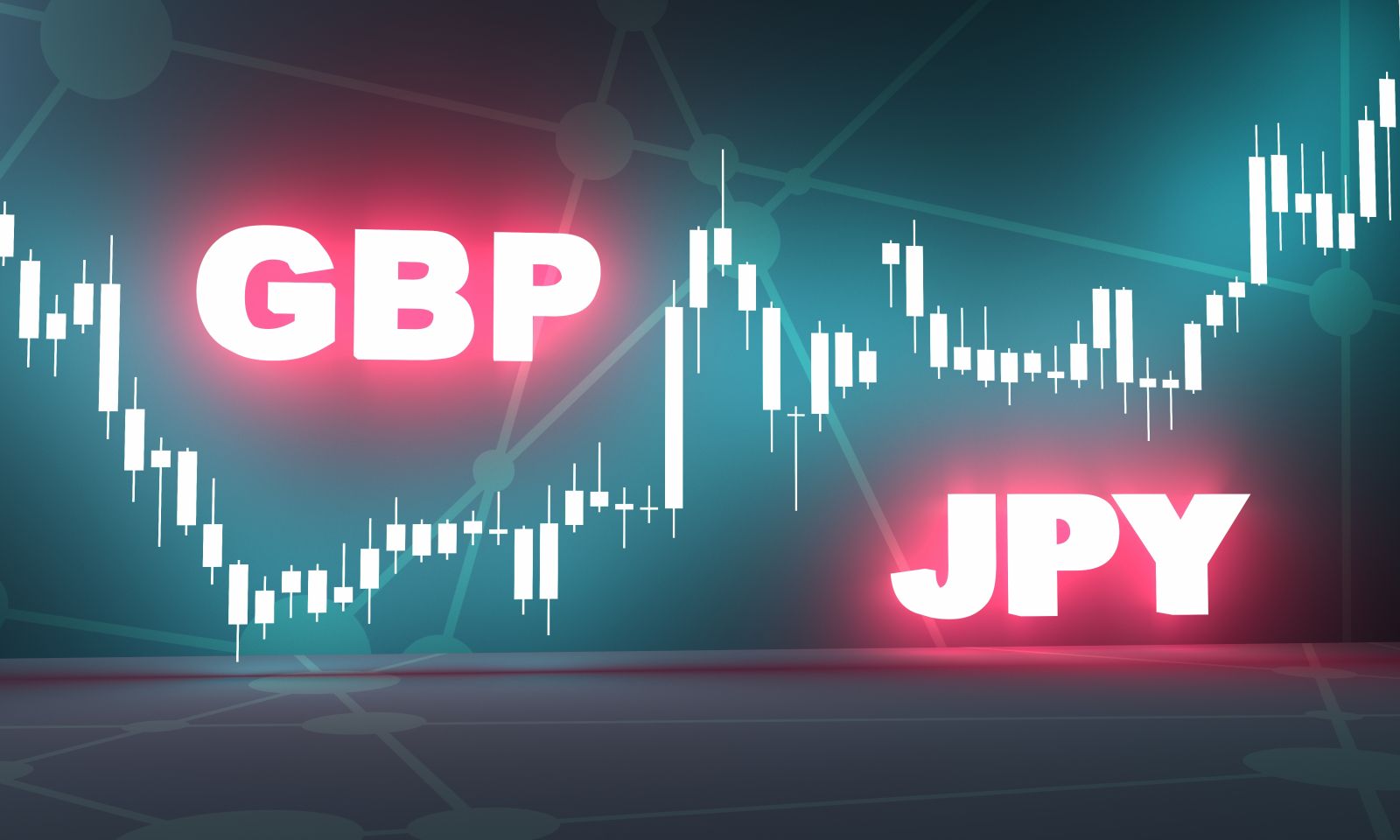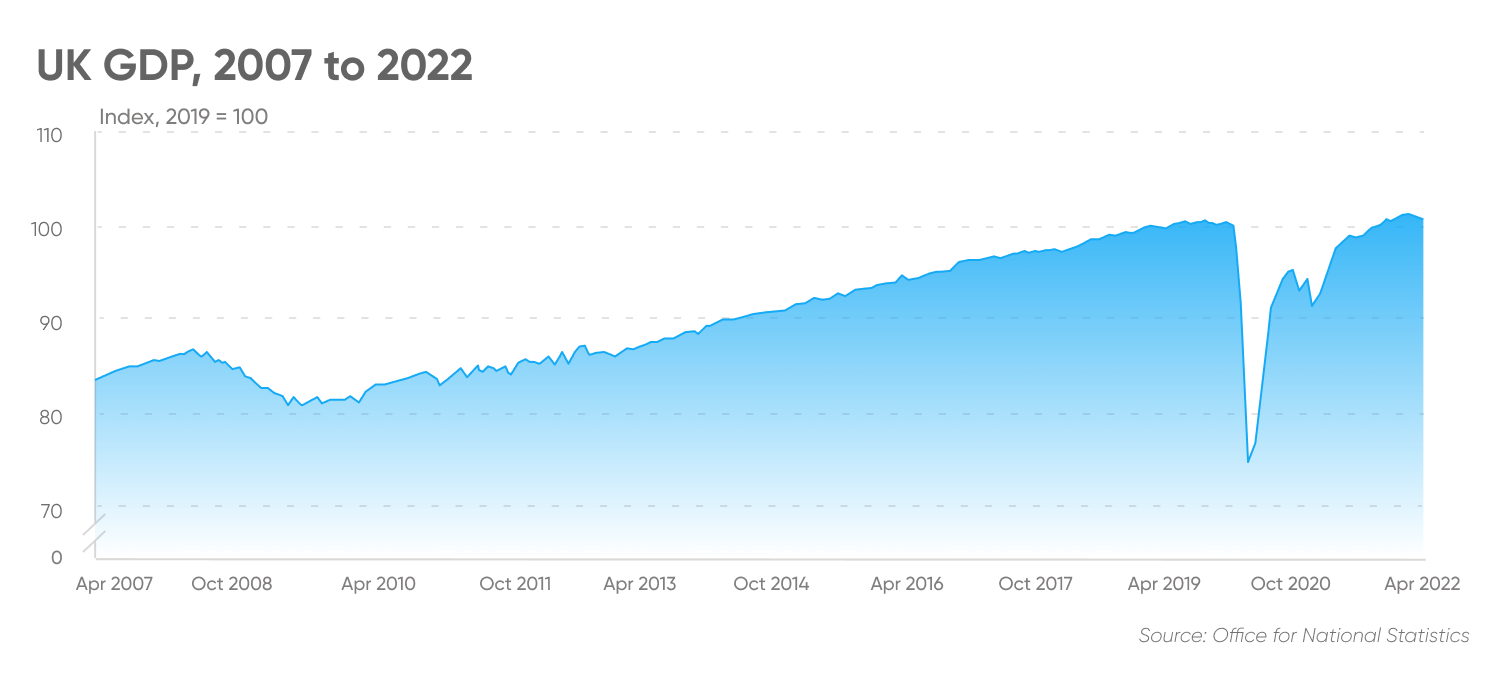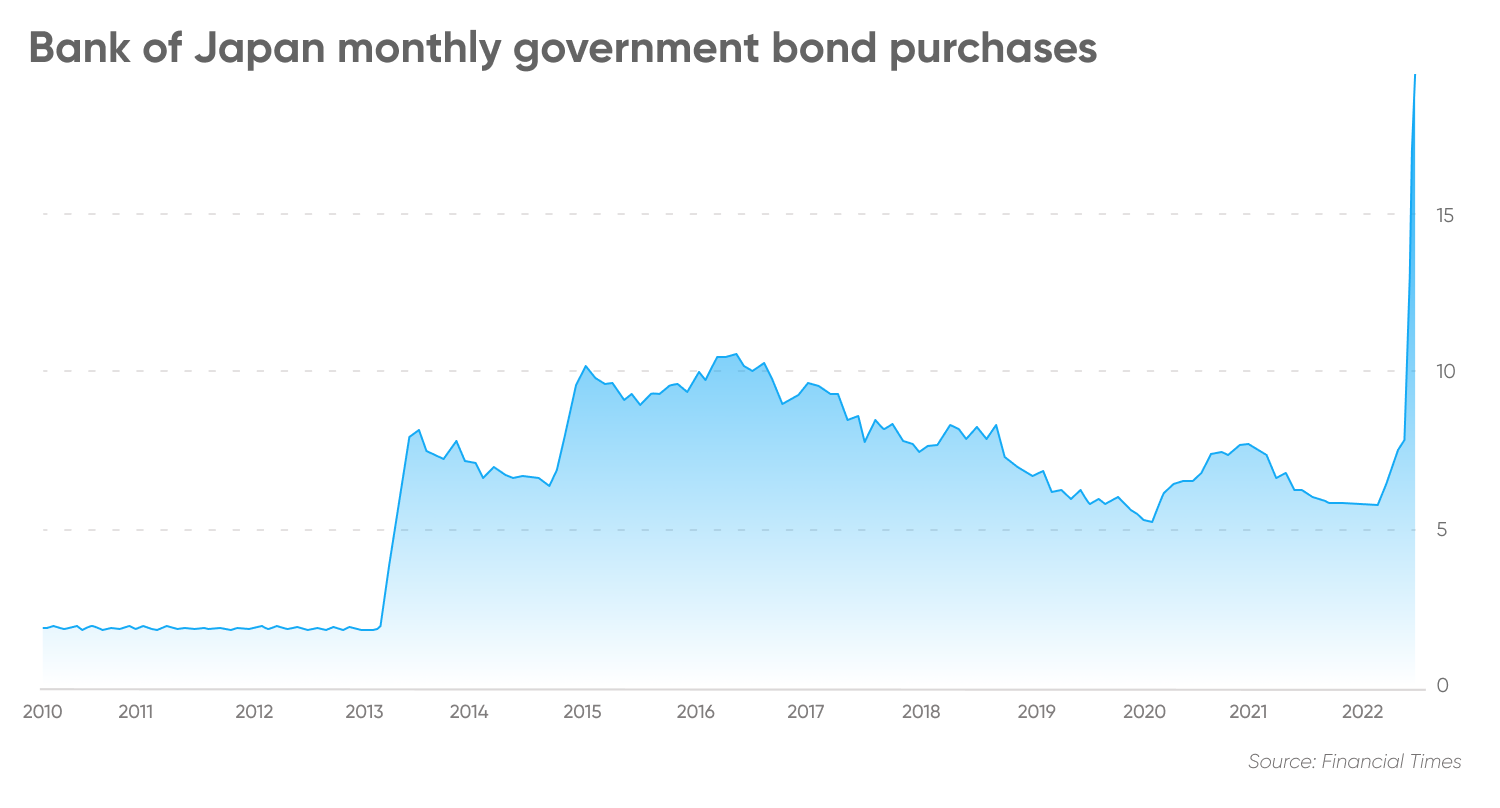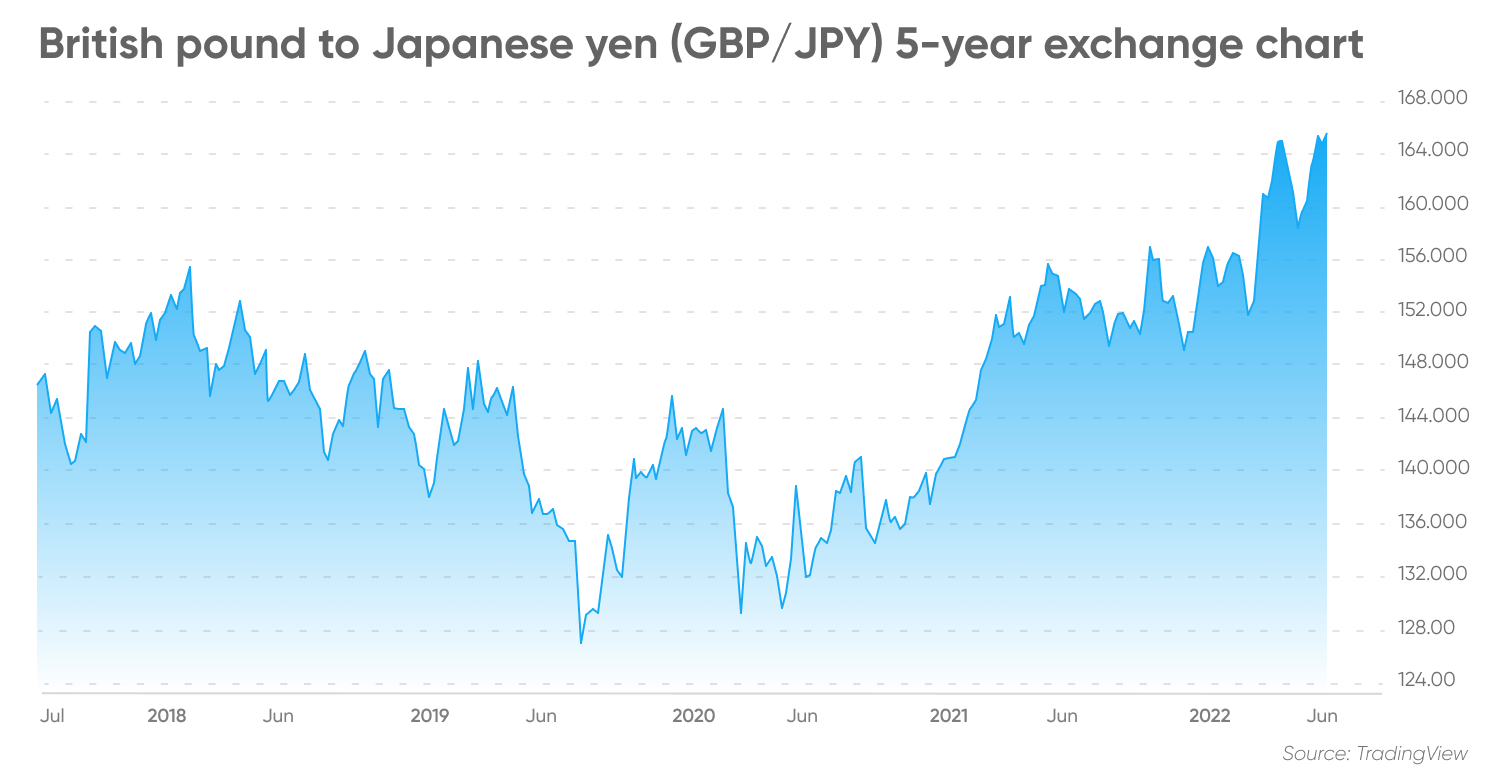GBP/JPY Forecast: Can GBP/JPY keep rising?
Risk sentiment and central bank action, or inaction have been driving the GBP/JPY pair
The British pound (GBP) rallied over 7% against the Japanese yen (JPY) at the start of the year as central bank divergence boosted the pair. However, with recession fears rising and the Bank of England (BoE) hiking cycle possibly slowing, can the pair keep rising, or is it downhill from here?
Read on for the latest pound and yen news, as well as analysts’ GBP/JPY forecasts for 2022 and beyond.
How has GBP/JPY moved so far in 2022?
After falling to a low of 124.06 in March 2020, GBP/JPY has been steadily climbing. Trading in 2022 has been choppier. The pair opened the year at 155.50, rising to a high of 168.43 on April 18 before falling to 155.60 and then climbing to 168.70. GBP/JPY was trading just marginally below this level at the time of writing on 29 June.
What’s been driving the pound?
The British pound has climbed across the year as inflation has risen and the BoE tightened monetary policy.
UK inflation was already rising heading into 2022. The Russian invasion of Ukraine has only fuelled inflation further. Western sanctions on Moscow tightened the energy supply, sending oil and gas prices higher. Ukraine is also an essential food producer, so food prices also jumped.
The surge in food, fuel and energy prices saw the Consumer price index (CPI) rise to 9.1% year-over-year (YOY) in May – a 40-year high. Producer prices, which measure inflation at the wholesale level, were also elevated at 22.1%. Producer price inflation (PPI) is often considered a lead indicator for consumer prices, suggesting that inflation could rise further. The BoE believed inflation would increase to 11%.
In its June Monetary Policy Committee (MPC) meeting, the BoE stated its post-pandemic tightening cycle at the end of last year and has continued into 2022. The central bank has raised interest rates at the past five meetings, taking the benchmark lending rate to 1.25% – the highest level in 13 years.
However, the UK economy is showing signs of stress and stalling growth. UK gross domestic product (GDP) contracted -0.1% in March and -0.3% in April. There are growing expectations that the UK economy will tip into recession, particularly if the BoE continues to hike rates. With this in mind, doubts are growing over how much more the BoE can raise rates.

Brexit
Six years after the UK’s EU referendum, Brexit risks continue to plague the economy and the value of the pound. UK Prime Minister Boris Johnson continues to press ahead with plans to pass legislation to scrap the rules on post-Brexit trade with Northern Ireland, which will almost certainly anger the EU. In a worst-case scenario, this could lead to a trade war, which could further slow growth and lift inflation.
What’s been moving the yen?
The Japanese yen is categorised for two key features: its safe-haven status and the BoJ’s very dovish stance.
Safe haven
The yen saw safe-haven demand surge following the coronavirus pandemic in 2020. Across 2021 as the market mood improved, the yen weakened. The Russia-Ukraine war has driven safe-haven demand up, creating volatility in JPY crosses as other major central banks tightened monetary policy.
More recently, the yen has benefitted from safe-haven flows as fears of a global economic slowdown. Investors worry that if the US Federal Reserve (Fed) hikes rates too aggressively, the US could fall into a recession, lifting safe-haven demand even higher.
Bank of Japan (BoJ)
The yen has been steadily weakening against the pound and other major forex pairs on central bank divergence. The BoJ is considered one of the most dovish major central banks, as BoJ chief Haruhiko Kurods believed an ultra-lose central bank policy was needed to bolster the economy, which has been stagnant for decades, while inflation remains low.
While major central banks across the globe are tightening monetary policy and raising interest rates, the BoJ is keeping interest rates low at -0.1% and is committed to keeping its yields low, with a 25% cap on benchmark yields.
However, the central bank has had to increase its bond purchases significantly in order to defend the yield curve cap, suggesting that it is coming under increasing strain.

There are growing questions over the BoJ’s ability to keep defending this 0.25% cap on benchmark yields, as it looks increasingly out of line with the global environment. The yen has weakened, notably on the BoJ’s accommodative policy, which means rising import costs squeezing both businesses and consumers.
That said, the BoJ’s rhetoric remains very dovish with no hints from policymakers that a change is coming. This also means the JPY is still a useful currency for the carry trade. In other words, investors borrow the yen to purchase other currencies with higher interest rates.
GBP/JPY forecast

With the UK possibly heading towards recession and the BoJ sticking with its dovish stance, what does it mean for GBP/JPY? Here we look at analysts’ GBP/JPY forecasts.
In his pound to Japanese yen forecast, FXstreet market analyst Yohay Elam noted:
As of 29 June, analysts at Danske Bank were bearish on their GBP/JPY forecast. They considered the pair could weaken over July to 161 from the current level of 164, s of 29 June. Danske Bank’s three month forecast sees the pair falling to 156 and to 149 over the coming 12 months. With regards to the pound, they said:
And regarding the yen:
Analysts at Citibank don’t cover the GBP/JPY – few analysts actually do. However, they were bearish on the outlook for GBP, drawing on the fact that the BoE is close to the end of its hiking cycle. They said:
Meanwhile, in their mid-term outlook for the currency, they consider that while the Japanese yen could remain weak, peak bearishness had passed.
As of 29 June, algorithm-based forecaster Wallet Investor predicted that the pair could rise modestly in the near term, ending 2022 at 167.51. Its GBP/JPY forecast for 2025 was for the rate to rise to 191.32 by the end of that year.
AI pickup’s GBP/JPY prediction saw the pound weakening to 162.96 by the end of this year and to 0.98 in 2025. The service’s GBP/JPY forecast for 2030 was at 113.81.
When looking at any GBP/JPY forecasts, remember that analysts can and do get their predictions wrong. We recommend you always do your research and consider the latest market trends and news, technical and fundamental analysis, and expert opinion before making any investment decisions. And never invest money you cannot afford to lose.
Stay up to date with the major forex pairs using our currency strength meter.
FAQs
Why is GBP/JPY dropping?
GBP/JPY has been falling in recent weeks amid growing doubts over how much further the Bank of England (BoE) can raise interest rates. Meanwhile, the Bank of Japan (BoJ), which is very dovish, could struggle to continue its current accommodative stance.
Furthermore, fears of a global recession as the US Federal Reserve hikes rates aggressively is helping boost demand for the safe-haven currency JPY.
Will GBP/JPY go up or down?
Whether GBP/JPY will go up or down depends on the economic health of each country and their central bank’s necessity to tighten or weaken monetary policy. In addition to central bank action, the risk environment will help determine whether GBP/JPY will go up or down. A risk-on backdrop would support GBP over the JPY and vice versa.
When is the best time to trade GBP/JPY?
While it is possible to trade GBP/JPY around the clock, the best hours to trade the currency pair are when it’s experiencing higher trading volumes – typically around major market announcements.
The BoE’s announcements and economic data releases are made during morning hours in London. Similarly, the Bank of Japan and the Japanese government release key data and make announcements during morning hours in Japan, with Japan Standard Time nine hours ahead of GMT.
Is GBP/JPY a buy or sell?
Whether GBP/JPY is a buy or a sell is largely dependent on the BoE’s ability to keep hiking rates and the BoJ’s ability to stick to its dovish stance. Given that the BoE’s hiking cycle could be shorter than initially expected and that the BoJ may, at some point, need to adopt a less dovish stance, the pair could struggle to rise further.
It also depends on the risk outlook and your personal investment goals. Should global recession fears grow, the GBP/JPY could fall quickly on safe-haven flows. Always do your own research. And remember to never invest more money than you can afford to lose.